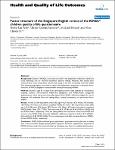Factor structure of the Singapore English version of the KINDL® children quality of life questionnaire
Wee, Hwee-Lin
Ravens-Sieberer, Ulrike
Erhart, Michael
Li, Shu-Chuen
Background: Quality of life (QoL) outcomes are useful in the assessment of physical, mental and social well-being and for informed healthcare decision making. However, few studies have evaluated QoL issues among Asian children due largely to the lack of culturally valid and reliable QoL questionnaires. Hence, we aimed to report the psychometric properties, in particular factor structure, of KINDL (Singapore) questionnaires among school-going children. Methods: Students aged 8–16 years from participating schools were selected by convenience sampling. Subjects self-completed KINDL-Kid (Singapore) and KINDL-Kiddo (Singapore) questionnaires, which were cross-culturally adapted from KINDL (Germany English) for use in Singapore. We evaluated floor and ceiling effects, internal consistency and performed factor analysis. Results: A total of 328 respondents (mean (SD) age: 9.6 (1.31) years; 67% female; 75% Chinese, 16% Malays, 9% Indians and others) completed KINDL-Kid while 1,026 respondents (mean (SD) age: 14.0 (1.00) years; 82% female; 82% Chinese, 12% Malays; 6% Indians and others) completed KINDL-Kiddo. Mean (SD) TOTAL QoL score was 65.5 (12.76) and 56.6 (11.92) for KINDL-Kid and KINDL-Kiddo, respectively. Floor and ceiling effects were important in five of six KINDL-Kid and two of six KINDL-Kiddo subscales. Reliability coefficients ranged from 0.40 to 0.71 (KINDL-Kid) and 0.44 to 0.84 (KINDL-Kiddo). Factor analysis generated eight and seven factors in KINDL-Kid and KINDL-Kiddo, respectively. Conclusion: KINDL-Kiddo exhibited good psychometric properties and may be used to assess QoL in this multi-ethnic English-speaking Asian population. However, psychometric properties of KINDL-Kid may need to be improved either by developing new items or modifying existing items.
No license information

